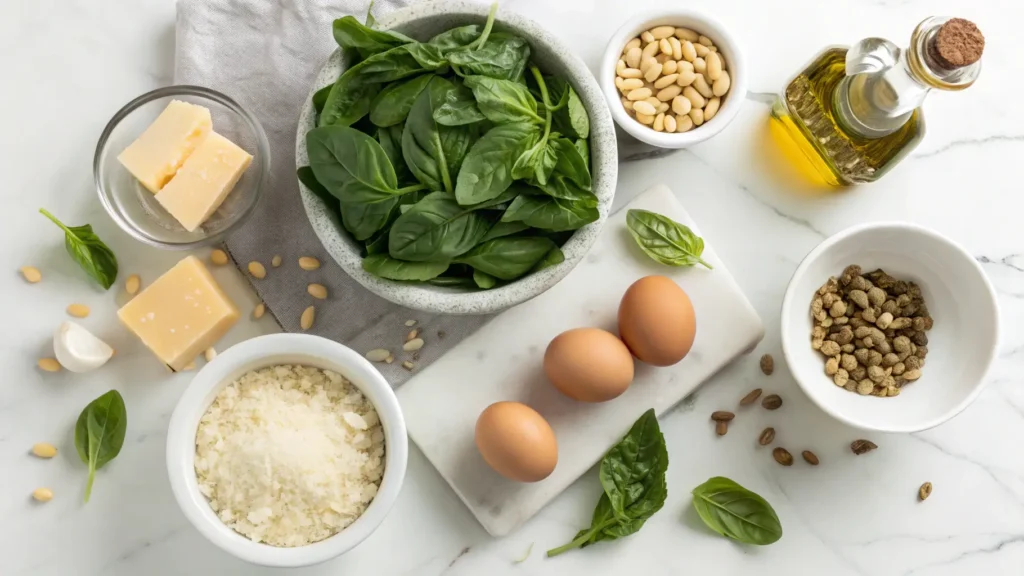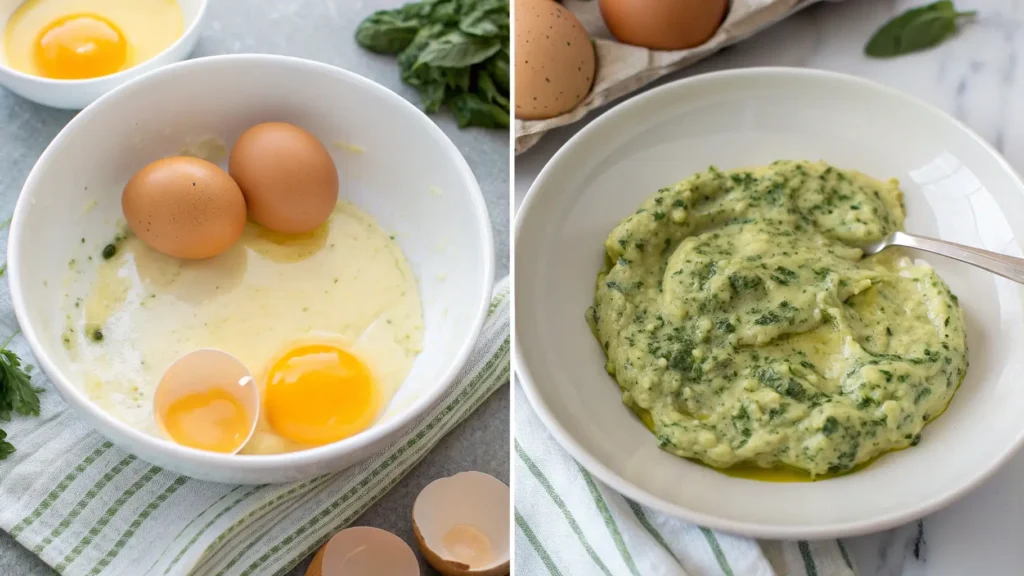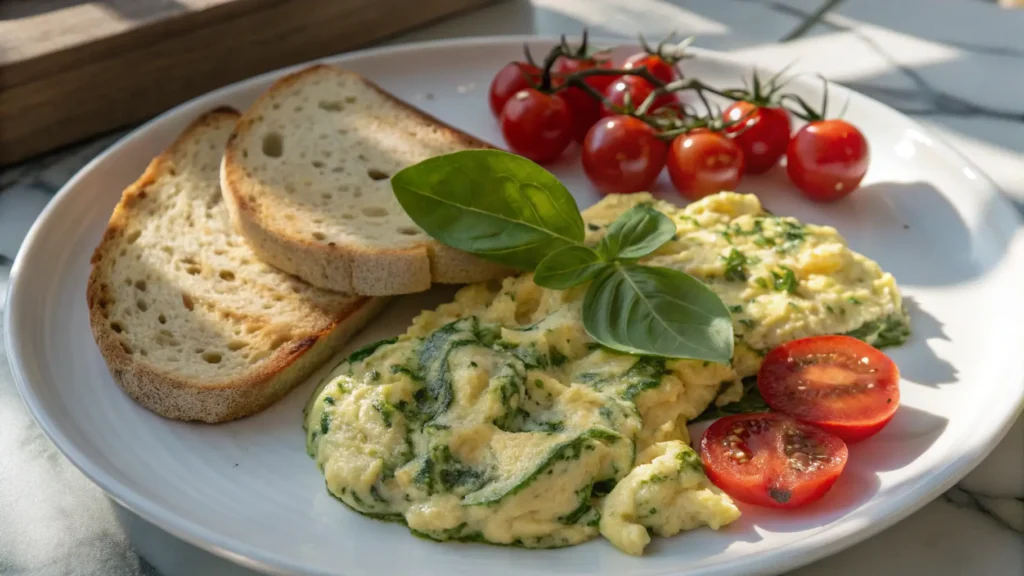Craving pesto eggs protein that actually deliver on both flavor and nutrition? This TikTok-famous recipe combines creamy scrambled eggs with fresh basil pesto for a protein-packed breakfast that tastes gourmet but takes just 10 minutes to make. With 18 grams of protein per serving, these pesto eggs have transformed from viral trend to sustainable family favorite.
What you’ll discover in this guide:
- Complete pesto eggs protein recipe with perfect texture every time
- How to make fresh basil pesto that elevates any egg dish
- Why this combination works so well for sustained morning energy
- Creative variations that keep the recipe interesting week after week
- Make-ahead tips for busy mornings without sacrificing flavor
- Nutritional benefits that support both muscle building and weight management
Table of Contents
The Saturday Morning That Started Our Pesto Obsession
It was one of those lazy Saturday mornings when Jake wandered into the kitchen scrolling through his phone and announced, “Mom, we HAVE to try this pesto eggs thing. Everyone’s making it.” My first instinct was to roll my eyes, how many TikTok food trends had we tried that looked amazing but tasted disappointing?
But something about the way the bright green pesto swirled into those creamy scrambled eggs caught my attention. Plus, I had a container of homemade pesto in the fridge that I’d been trying to use up. “Fine,” I said, “but only if you help make them.”
Twenty minutes later, we were both sitting at the kitchen island with plates of the most beautiful, fragrant scrambled eggs I’d ever made. The pesto didn’t just add color, it transformed ordinary eggs into something that tasted like it belonged at a fancy brunch restaurant. Jake took his first bite and his eyes widened. “Okay, this is actually incredible.”
What started as weekend TikTok experimentation has become our Saturday morning ritual. Six months later, these pesto eggs protein are still requested weekly, and I’ve perfected the recipe to maximize both the flavor and the nutrition that keeps us satisfied until lunch.
The Complete Pesto Eggs Protein Recipe
Ingredients:
For the Pesto Eggs:
- 6 large eggs
- 3 tablespoons fresh basil pesto (homemade or high-quality store-bought)
- 2 tablespoons heavy cream or milk
- 2 tablespoons butter
- Salt and freshly ground black pepper to taste
- 2 tablespoons grated Parmesan cheese (optional)
For Homemade Basil Pesto (makes extra):
- 2 cups fresh basil leaves, packed
- 3 cloves garlic
- 1/3 cup pine nuts
- 1/2 cup extra virgin olive oil
- 1/2 cup freshly grated Parmesan cheese
- Salt and pepper to taste
For Serving:
- Toasted sourdough bread or English muffins
- Cherry tomatoes, halved
- Additional fresh basil leaves
- Extra grated Parmesan

Instructions:
Make the Pesto (if using homemade):
- Toast the pine nuts: In a dry skillet over medium heat, toast pine nuts for 2-3 minutes until lightly golden and fragrant. Let cool.
- Blend the pesto: In a food processor, pulse garlic until minced. Add basil leaves and toasted pine nuts, pulse until roughly chopped. With processor running, slowly drizzle in olive oil until mixture is smooth but still has some texture.
- Finish and season: Add Parmesan cheese, salt, and pepper. Pulse a few more times to combine. Taste and adjust seasoning.
Make the Pesto Eggs:
- Prep for cooking: Crack eggs into a bowl and whisk with cream or milk, salt, and pepper until well combined. Have your pesto ready and measured.
- Start the eggs: Heat butter in a non-stick skillet over medium-low heat. Pour in the egg mixture and let it sit for 30 seconds without stirring.
- Create creamy texture: Using a silicone spatula, gently push the eggs from one side of the pan to the other, allowing the uncooked egg to flow underneath. Continue this process slowly and patiently.
- Add the magic: When eggs are about 70% cooked but still quite wet, remove pan from heat and immediately stir in the pesto. The residual heat will finish cooking the eggs while the pesto creates beautiful green swirls.
- Final touches: Gently fold the pesto through the eggs, creating marbled patterns. Taste and adjust seasoning. Sprinkle with Parmesan if using.
- Serve immediately: Plate the pesto eggs alongside toasted bread, cherry tomatoes, and fresh basil. Serve while still warm and creamy.
Prep Time: 10 minutes (plus 5 minutes for homemade pesto)
Cook Time: 5 minutes
Total Time: 15 minutes
Serves: 2-3
What Makes Pesto Eggs Protein a Nutritional Powerhouse
The combination of eggs and pesto creates more than just Instagram-worthy breakfast plates – it delivers a complete amino acid profile alongside healthy fats and fresh herbs that support optimal morning nutrition. Unlike typical breakfast carbs that cause energy crashes, this protein-fat combination provides sustained energy for hours.
The eggs contribute high-quality complete protein that supports muscle maintenance and satiety, while the basil pesto adds healthy fats from olive oil and pine nuts that slow digestion and enhance nutrient absorption. The fresh herbs provide antioxidants and natural flavor compounds that make healthy eating feel indulgent rather than restrictive.
Why pesto eggs protein work for active families:
- Sustained energy: Protein and healthy fats prevent mid-morning crashes
- Complete nutrition: All essential amino acids plus vitamins and minerals
- Quick preparation: Ready in under 10 minutes on busy mornings
- Flavor satisfaction: Rich, complex taste that feels like a special treat
- Versatile base: Works with various vegetables and serving styles
Our Six-Month Pesto Eggs Evolution
What began as a viral recipe experiment has evolved into our most customizable breakfast. Here’s how we’ve made pesto eggs protein work for different moods and nutritional needs:
The “Classic Weekend” Version:
- Full recipe as written with homemade pesto
- Served with thick sourdough toast and roasted cherry tomatoes
- Jake’s weekend favorite that feels special every time
The “Weekday Speed” Version:
- Store-bought quality pesto for quick preparation
- Served over spinach for extra vegetables
- Ready in 5 minutes for busy school mornings
The “Veggie-Packed” Version:
- Sautéed mushrooms and spinach folded in with the pesto
- Adds fiber and additional nutrients
- Emma’s preferred version when she wants “more green stuff”
The “Protein Boost” Version:
- Add crumbled goat cheese or feta during cooking
- Increases protein to over 20 grams per serving
- Perfect for post-workout recovery or very active days
The “Mediterranean” Version:
- Sun-dried tomatoes and olives mixed in
- Served with warm pita bread
- Feels like vacation breakfast at home

The Science Behind Perfect Pesto Eggs Texture
After months of making these eggs, I’ve learned the techniques that create restaurant-quality results every single time:
Low and slow wins: Medium-low heat prevents the eggs from becoming tough or rubbery. Patience creates that creamy, custard-like texture that makes these eggs special.
Timing the pesto addition: Adding pesto too early can cause it to separate or become bitter from overcooking. The sweet spot is when eggs are almost set but still slightly wet – the residual heat warms the pesto without destroying its fresh flavor.
The stirring technique: Gentle folding rather than aggressive scrambling creates those beautiful marbled patterns while maintaining creamy texture. Think of it as painting with your spatula.
Fresh vs. store-bought pesto: Homemade pesto definitely tastes better, but high-quality store-bought versions work well for busy mornings. The key is using brands that list basil as the first ingredient.
Temperature control: Remove the pan from heat before adding pesto. The eggs will continue cooking from residual heat while the pesto stays bright and fresh-tasting.
Making Pesto Eggs Protein Work for Busy Families
These eggs have become our solution for mornings when we want something special but don’t have time for complicated cooking:
Sunday prep strategy:
- Make a large batch of pesto on Sunday
- Pre-crack eggs into containers for quick weekday cooking
- Toast bread in advance and store in airtight containers
- 5-minute assembly throughout the week
Portion control approach:
- Recipe easily scales up or down based on family size
- Two eggs per person provides substantial protein
- Serve with vegetables to create complete, balanced meals
Customization system:
- Keep basic pesto eggs as the foundation
- Let family members add their preferred vegetables or cheese
- No more “I don’t like that” complaints at breakfast
Your Complete Protein-Powered Morning Collection
When you’re building a sustainable morning protein routine that goes beyond just one recipe, these pesto eggs protein work best as part of a varied breakfast strategy that keeps your family interested and well-nourished.
For mornings when you want something equally quick but with different flavors, my Protein Egg Scrambles provide the same high-protein foundation with customizable mix-ins that satisfy different taste preferences. The versatility means you can use whatever vegetables or cheese you have on hand, making it perfect for using up leftovers.
When weekend mornings call for something more substantial and indulgent, Protein Waffles deliver that special breakfast feeling while packing serious nutrition. They’re perfect for those times when pesto eggs feel too light or when you’re feeding a crowd that wants something heartier.
For liquid nutrition that complements these rich, savory eggs, my Chia Water provides gentle hydration and sustained energy, while my Blue Spirulina Smoothie offers antioxidant power when you want something refreshing alongside your protein-rich eggs.
When you need portable options for busy mornings, my Blueberry Protein Muffins deliver 8 grams of protein in grab-and-go format, perfect for alternating with sit-down pesto eggs depending on your schedule.
The beauty of having multiple protein breakfast options is that you never get stuck in a rut, and different family members can choose what works best for their appetite and energy needs on any given morning.
Nutritional Benefits That Support Your Goals
What makes pesto eggs protein particularly valuable is how they deliver multiple nutritional benefits in one satisfying meal:
- Complete protein profile: Eggs provide all nine essential amino acids necessary for muscle maintenance, brain function, and sustained energy production
- Healthy fat integration: Olive oil and pine nuts in pesto support hormone production and nutrient absorption
- Antioxidant boost: Fresh basil provides compounds that support immune function and reduce inflammation
- Mineral support: Eggs contribute choline for brain health, selenium for immune function, and B vitamins for energy metabolism
- Satiety factor: The protein-fat combination keeps hunger at bay for 4-5 hours

Per serving (using 2 eggs plus pesto):
- Calories: 320
- Protein: 18g
- Carbohydrates: 3g
- Fat: 26g (primarily healthy fats)
- Fiber: 1g
- Choline: 250mg (important for brain health)
Creative Variations That Keep It Interesting
After months of weekend pesto eggs, we’ve discovered variations that prevent flavor fatigue while maintaining the protein benefits:
Seasonal adaptations:
- Spring: Add asparagus tips and fresh chives
- Summer: Include cherry tomatoes and fresh corn
- Fall: Fold in sautéed butternut squash and sage
- Winter: Add roasted red peppers and extra Parmesan
International inspirations:
- Italian: Sun-dried tomatoes and mozzarella
- Greek: Feta cheese and Kalamata olives
- Mexican: Avocado and a pinch of cumin
- French: Herbes de Provence and goat cheese
Dietary modifications:
- Dairy-free: Use nutritional yeast instead of Parmesan in pesto
- Lower fat: Use less olive oil and add vegetable broth to pesto
- Higher protein: Add cottage cheese or Greek yogurt
- Keto-friendly: Serve over sautéed spinach instead of bread
Storage and Make-Ahead Strategies
While pesto eggs are best enjoyed fresh, strategic preparation makes weekday versions completely achievable:
Pesto storage:
- Homemade pesto keeps 1 week refrigerated with oil layer on top
- Freeze pesto in ice cube trays for individual portions
- Thaw overnight or microwave for 15 seconds before using
Egg preparation:
- Pre-crack eggs into containers the night before
- Add cream and seasoning for one-step cooking
- Store up to 2 days in refrigerator
Component cooking:
- Toast bread in advance and store in airtight containers
- Pre-cut vegetables and store in refrigerator
- Reheat bread in toaster for fresh texture
Troubleshooting Common Pesto Eggs Issues
Eggs too rubbery? Lower your heat and cook more slowly. High heat is the enemy of creamy scrambled eggs.
Pesto looks separated? You added it too early while eggs were still actively cooking. Next time, remove from heat first.
Not enough flavor? Taste your pesto before adding – it should be well-seasoned on its own. Also, don’t be afraid to use enough pesto for visible marbling.
Pesto tastes bitter? Your basil may have been processed too long or the garlic was burned. Fresh, gentle processing creates the best flavor.
Too oily? Use less olive oil in homemade pesto, or choose a store-bought version with less oil content.
If this brought warmth to your kitchen, share it with someone you love. and make sure you Follow on Facebook.
FAQ About Pesto Eggs Protein
What makes pesto eggs protein different from regular scrambled eggs?
Pesto eggs protein combine the complete amino acid profile of eggs with the healthy fats and antioxidants from basil pesto, creating a more nutritionally complete and satisfying meal. The pesto adds healthy monounsaturated fats that slow digestion and enhance satiety, while the fresh herbs provide antioxidants and complex flavors that make the dish feel gourmet rather than basic. This combination delivers sustained energy that lasts much longer than plain eggs.
Can I use store-bought pesto for pesto eggs protein?
Absolutely! High-quality store-bought pesto works well for pesto eggs protein, especially for busy weekday mornings. Look for brands that list basil as the first ingredient and avoid those with excessive preservatives or artificial colors. The key is using enough pesto to create visible marbling through the eggs – typically 2-3 tablespoons per 4-6 eggs. Homemade pesto tastes fresher, but good store-bought versions make this recipe accessible for daily use.
How much protein do pesto eggs actually provide?
Pesto eggs protein typically provide 15-20 grams of protein per serving, depending on the number of eggs used. Two large eggs contribute about 12 grams of complete protein, while the pesto adds additional protein from pine nuts and Parmesan cheese. This protein level supports muscle maintenance, promotes satiety, and provides sustained energy for 4-5 hours. For higher protein needs, you can add extra cheese or serve with Greek yogurt on the side.
What’s the best way to get the marbled effect in pesto eggs?
Achieve the perfect marbled effect in pesto eggs by adding the pesto when the eggs are about 70% cooked but still wet and creamy. Remove the pan from heat before adding pesto, then gently fold it through with a silicone spatula using figure-eight motions. Don’t overmix – you want distinct green swirls rather than completely green eggs. The residual heat from the eggs will warm the pesto without cooking it, preserving both the color and fresh flavor.

The Best Pesto Eggs Protein
- Total Time: 15 minutes
- Yield: 2–3 servings 1x
Description
These viral pesto eggs protein combine creamy scrambled eggs with fresh basil pesto for a TikTok-famous breakfast that delivers 18g of protein. Ready in 10 minutes with restaurant-quality results!
Ingredients
- 6 large eggs
- 3 tablespoons fresh basil pesto (homemade or store-bought)
- 2 tablespoons heavy cream or milk
- 2 tablespoons butter
- Salt and freshly ground black pepper to taste
- 2 tablespoons grated Parmesan cheese (optional)
For homemade pesto (optional):
- 2 cups fresh basil leaves, packed
- 3 cloves garlic
- 1/3 cup pine nuts
- 1/2 cup extra virgin olive oil
- 1/2 cup freshly grated Parmesan cheese
- Salt and pepper to taste
For serving:
- Toasted sourdough bread or English muffins
- Cherry tomatoes, halved
- Additional fresh basil leaves
- Extra grated Parmesan
Instructions
- 1. Make pesto (if homemade): Toast pine nuts in dry skillet 2-3 minutes until golden. In food processor, pulse garlic until minced. Add basil and pine nuts, pulse until chopped. With processor running, slowly add olive oil until smooth. Add Parmesan, salt, pepper and pulse to combine.
- 2. Prep eggs: Crack eggs into bowl and whisk with cream, salt, and pepper until well combined. Have pesto measured and ready.
- 3. Start cooking: Heat butter in non-stick skillet over medium-low heat. Pour in egg mixture and let sit 30 seconds without stirring.
- 4. Create creamy texture: Using silicone spatula, gently push eggs from one side to other, allowing uncooked egg to flow underneath. Continue slowly and patiently.
- 5. Add pesto magic: When eggs are 70% cooked but still wet, remove pan from heat and immediately stir in pesto. Residual heat finishes cooking while creating green swirls.
- 6. Final touches: Gently fold pesto through eggs creating marbled patterns. Taste and adjust seasoning. Sprinkle with Parmesan if using.
- 7. Serve immediately: Plate pesto eggs alongside toasted bread, cherry tomatoes, and fresh basil while still warm and creamy.
Notes
Use medium-low heat for creamy texture.
Add pesto off heat to prevent separation.
Homemade pesto tastes best but quality store-bought works for busy mornings.
Don’t overmix – you want marbled swirls, not completely green eggs.
Best served immediately while warm.
- Prep Time: 10 minutes
- Cook Time: 5 minutes
- Category: Breakfast
- Method: Scrambling
- Cuisine: Italian-Inspired
Nutrition
- Serving Size: 1 portion (about 2 eggs with pesto)
- Calories: 320 Calories
- Sugar: 1g
- Sodium: 380 mg
- Fat: 26g
- Saturated Fat: 8g
- Unsaturated Fat: 18g
- Carbohydrates: 3g
- Fiber: 1g
- Protein: 18g
- Cholesterol: 375mg




